Born in 1870, Arthur V. Diehl emigrated from England to the United States in his early 20s and hustled throughout his life to earn a living as a painter. In 1913, he established a studio in Provincetown, which became a defining place for him. Here he built an audience for his artwork and found abundant subjects in the town’s dunes, wharfs, and gabled houses.
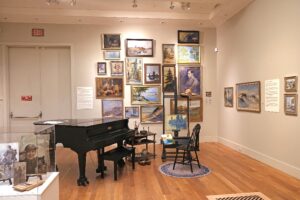
Diehl never achieved the renown of Provincetown’s more well-known artists of the period. Now, an exhibition titled “The Life and Art of Arthur V. Diehl” at the Cape Cod Museum of Art in Dennis explores the arc of Diehl’s career, which was guided by the artist’s restless and impulsive spirit. The show reveals a painter known as much for his personality and showmanship as for his artistic accomplishments.
The exhibit, curated by the artist’s granddaughter Eugenia Diehl Pell, includes a wide array of paintings and a miniature recreation of his studio below a wall of paintings hung salon-style. A handful of photographs in the exhibition captures his charismatic energy. In one painting, he paints in his studio with a crowd of well-dressed onlookers.
Diehl was well known for painting speedily. In a handsome and well-researched monograph accompanying the exhibition, Pell includes an account of Diehl completing 24 small paintings in one day.
“People were mesmerized by his speed and accuracy,” says Benton Jones, director of art at the museum. A 1917 article in the Provincetown Advocate described his images as “like-lightning-executed oil paintings.”
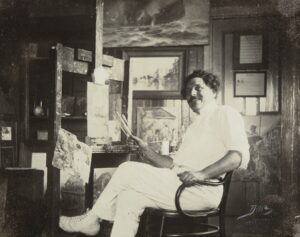
That article goes on to describe Diehl’s painting of a torpedoed ocean liner slowly sinking. It’s not in the exhibition but figures in the background of a photograph where Diehl sits back in a chair, cheerfully looking upward with a fistful of brushes. There are other maritime images on display, including an image of a sinking liner and fleeing lifeboats, most likely informed by his experience of witnessing a shipwreck off Truro’s Ballston Beach in October 1912.
Diehl was primarily a studio painter who worked from memory. His restlessness facilitated easy and frequent shifts in subject matter, drawing on his experiences and travels. He moved between motifs as diverse as shipwrecks, European pastoral scenes, still lifes, and Orientalist-inflected images of Morocco.
His style and range of influences showed a similar openness to variety. In her monograph, Pell identifies the French Barbizon style as among his most significant influences — particularly the movement’s “affinity for a muted palette and limited tonal range, soft forms, and loose brushwork.”
Farmlands — a scene of cows and a marsh — exemplifies that Barbizon affinity. The clouds are rendered in swirls of thick paint, and the sky’s reflection in the water is both dense with paint and airy in color. Stylistically, Diehl seemed most at home making paintings with loose brushwork, capturing vivid experiences of light and weather.
Overlooking Provincetown is one of the exhibition’s smallest paintings but also one of its most successful. Its small scale compresses Diehl’s energy into a digestible and focused artwork that seems to come together in one breath. Here, his busy hand — sketching out the architecture of buildings, depicting a figure changing a tire — conveys both his frenetic energy and the specificity of a scene and time of day.
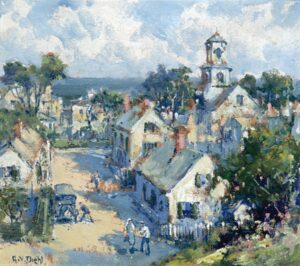
As a young man, Diehl studied in Milan where he spent hours copying masterpieces at the Brera Academy. Later, as a young artist in New York, he made a living producing copies of paintings. Emulation came easily for him. The exhibition’s salon-style wall of paintings catalogs his varying stylistic experiments: there’s a flat painting of a woman applying lipstick, a nod to illustration; a moody lake scene in muted blues and green, reminiscent of Monet; and an American street scene that feels more realist than Barbizon.
A commitment to new experiences and new places seemed to shape the trajectory of Diehl’s life. At 17, after returning from two years studying in Italy and traveling around Europe, he married a 40-year-old nurse. She died in New York after they emigrated, leaving him with an infant daughter, who was adopted by a family member. Another marriage to an actress also left him a widower with another young child. But his third marriage, which yielded one son, proved more durable.
Diehl lived with his family in New Jersey before establishing a base in Bourne, where a Boston patron provided him a place to live. He first came to the Outer Cape as a vacationer at Truro’s Ballston Beach Bungalows in 1906. By 1913, he was painting and holding court in a Provincetown studio on Commercial Street. “My grandfather was a showman by nature and relished painting in front of a crowd,” writes Pell, who never met him but recounts many stories she heard about him.
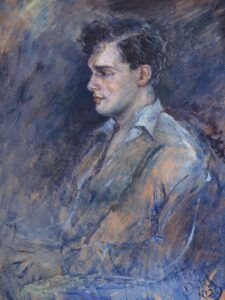
Diehl remained a summertime presence in Provincetown until shortly before his death in 1929. He was never integrated fully in the art scene of the town, but he caught the attention of Ross Moffett, who described him as a bit of a charlatan in his book Art in Narrow Streets, while also conceding that he was an “amazing and rather magnificent Englishman,” able to “paint a dune or beach scene in a few minutes, while keeping up an entertaining, impressive, and largely one-sided conversation.”
In the winters, Diehl left Provincetown and moved around, setting up studios and selling artwork in Asbury Park, N.J.; St. Augustine, Fla.; and New Haven, Conn.
Diehl’s paintings of Provincetown wharfs — a favorite subject — capture a time when schooners and sailboats dominated the harbor. In Wharf, Provincetown, he captures fishermen stretching out nets, tying up boats, and hauling in buckets of the day’s catch. A band of warm color, painted thickly, stretches above the horizon line describing a break of light in the clouds. It’s a poetic reprieve from the industriousness and grayness of the scene.

Diehl seemed most settled in his paintings of Provincetown’s dunes. He captures the quiet of this landscape in a series of paintings that contrast its gentle and sensuous curves against a rigid horizon line, and he revels in the interplay of warm and cool colors found in the shadows and illuminated domes. Sunny Sand Dune is particularly evocative. Here, Diehl communicates the experience of the landscape: the softness of the sand, the gentle breeze, the promise of water beckoning over the dunes.
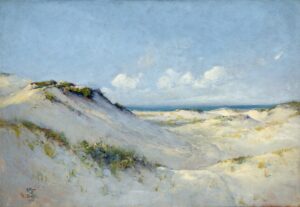
Diehl painted a portrait of his son as one of his last works, done moments before leaving for the hospital for an operation that would ultimately prove unsuccessful in treating his cancer. On view in the exhibition, it captures his college-age son in the prime of youth. Much of the painting is sketchy and unfinished, but the youth’s face is captured in full detail. His red lips and ruddy complexion pulsate with a life force that Diehl likely felt was slipping from his own body.
Nearly 100 years later, the portrait typifies Diehl’s lifelong project of lustily grasping onto life — in all its vitality, energy, and curiosity — and quickly putting it on canvas before the experience was lost.
Showman With a Paintbrush
The event: “The Life and Art of Arthur V. Diehl”
The time: Through July 23
The place: Cape Cod Museum of Art, 60 Hope Lane, Dennis
The cost: $10 general admission



